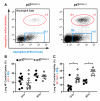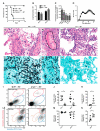Tracing conidial fate and measuring host cell antifungal activity using a reporter of microbial viability in the lung
- PMID: 23200858
- PMCID: PMC3712646
- DOI: 10.1016/j.celrep.2012.10.026
Tracing conidial fate and measuring host cell antifungal activity using a reporter of microbial viability in the lung
Abstract
Fluorescence can be harnessed to monitor microbial fate and to investigate functional outcomes of individual microbial cell-host cell encounters at portals of entry in native tissue environments. We illustrate this concept by introducing fluorescent Aspergillus reporter (FLARE) conidia that simultaneously report phagocytic uptake and fungal viability during cellular interactions with the murine respiratory innate immune system. Our studies using FLARE conidia reveal stepwise and cell-type-specific requirements for CARD9 and Syk, transducers of C-type lectin receptor and integrin signals, in neutrophil recruitment, conidial uptake, and conidial killing in the lung. By achieving single-event resolution in defined leukocyte populations, the FLARE method enables host cell profiling on the basis of pathogen uptake and killing and may be extended to other pathogens in diverse model host organisms to query molecular, cellular, and pharmacologic mechanisms that shape host-microbe interactions.
Copyright © 2012 The Authors. Published by Elsevier Inc. All rights reserved.
Figures





Similar articles
-
Activation of NF-κB and respiratory burst following Aspergillus fumigatus stimulation of macrophages.Immunobiology. 2014 Jan;219(1):25-36. doi: 10.1016/j.imbio.2013.06.013. Epub 2013 Jul 4. Immunobiology. 2014. PMID: 23886693
-
Compartment-specific and sequential role of MyD88 and CARD9 in chemokine induction and innate defense during respiratory fungal infection.PLoS Pathog. 2015 Jan 26;11(1):e1004589. doi: 10.1371/journal.ppat.1004589. eCollection 2015 Jan. PLoS Pathog. 2015. PMID: 25621893 Free PMC article.
-
During Aspergillus Infection, Monocyte-Derived DCs, Neutrophils, and Plasmacytoid DCs Enhance Innate Immune Defense through CXCR3-Dependent Crosstalk.Cell Host Microbe. 2020 Jul 8;28(1):104-116.e4. doi: 10.1016/j.chom.2020.05.002. Epub 2020 Jun 1. Cell Host Microbe. 2020. PMID: 32485165 Free PMC article.
-
The immune interplay between the host and the pathogen in Aspergillus fumigatus lung infection.Biomed Res Int. 2013;2013:693023. doi: 10.1155/2013/693023. Epub 2013 Jul 30. Biomed Res Int. 2013. PMID: 23984400 Free PMC article. Review.
-
Host defense mechanisms against Aspergillus fumigatus lung colonization and invasion.Curr Opin Microbiol. 2019 Dec;52:14-19. doi: 10.1016/j.mib.2019.04.003. Epub 2019 May 16. Curr Opin Microbiol. 2019. PMID: 31103956 Free PMC article. Review.
Cited by
-
The balance between immunity and inflammation.Science. 2017 Sep 8;357(6355):973-974. doi: 10.1126/science.aao3086. Science. 2017. PMID: 28883060 Free PMC article.
-
Migrating Lung Monocytes Internalize and Inhibit Growth of Aspergillus fumigatus Conidia.Pathogens. 2020 Nov 24;9(12):983. doi: 10.3390/pathogens9120983. Pathogens. 2020. PMID: 33255432 Free PMC article.
-
Mitochondrial Reactive Oxygen Species Enhance Alveolar Macrophage Activity against Aspergillus fumigatus but Are Dispensable for Host Protection.mSphere. 2021 Jun 30;6(3):e0026021. doi: 10.1128/mSphere.00260-21. Epub 2021 Jun 2. mSphere. 2021. PMID: 34077261 Free PMC article.
-
Macrophages inhibit Aspergillus fumigatus germination and neutrophil-mediated fungal killing.PLoS Pathog. 2018 Aug 2;14(8):e1007229. doi: 10.1371/journal.ppat.1007229. eCollection 2018 Aug. PLoS Pathog. 2018. PMID: 30071103 Free PMC article.
-
Macrophage Lysosomal Alkalinization Drives Invasive Aspergillosis in a Mouse Cystic Fibrosis Model of Airway Transplantation.J Fungi (Basel). 2022 Jul 20;8(7):751. doi: 10.3390/jof8070751. J Fungi (Basel). 2022. PMID: 35887506 Free PMC article.
References
-
- Boyle KB, Gyori D, Sindrilaru A, Scharffetter-Kochanek K, Taylor PR, Mócsai A, Stephens LR, Hawkins PT. Class IA phosphoinositide 3-kinase β and δ regulate neutrophil oxidase activation in response to Aspergillus fumigatus hyphae. J. Immunol. 2011;186:2978–2989. - PubMed
Publication types
MeSH terms
Substances
Grants and funding
LinkOut - more resources
Full Text Sources
Other Literature Sources
Medical
Molecular Biology Databases
Miscellaneous

